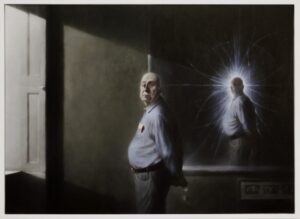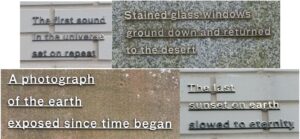Art and the sense of belonging in the neighbourhood of JCMB, King’s Buildings

Spyros Dallas, an MSc Computational Mathematical Finance student, explores the ways in which the artistic features of the King’s Buildings campus foster a sense of community.
Finding a sense of belonging in a place often comes from the connections we make with its sights, its people, and the experiences we share within its bounds. The James Clerk Maxwell Building (JCMB) at King’s Buildings Campus serves as a perfect example of how a space is more than just a location, transforming into a cornerstone of community and identity for its students and faculty.
Nestled among landmarks like the Murray Library, the Quad Park, and the Nucleus Building, JCMB stands out with its distinctive brick exterior. An interesting piece of trivia that circulates among students is the idea that JCMB’s design was inspired by the architecture of the earliest computers—a rumour that adds to its already unique character.

One of the first art pieces to greet newcomers is the striking portrait of the late Professor Peter Higgs by Scottish painter Ken Currie. Positioned on the staircase between the second and third floors, this piece captures Higgs in a moment of deep thought, seemingly interrupted by the viewer’s presence. As he turns outward, his gaze meets ours, while in the background, a reflection adorned with Higgs bosons—central to his Nobel Prize-winning work—gazes in the opposite direction. This work honours Higgs’s scientific achievements while creating a moment of connection between the observer and the observed.
Further into the building, a bronze statue of James Clerk Maxwell offers a moment of reflection on the contributions of this pioneering scientist to electromagnetic theory. His presence, coupled with his equations adorning the corridors, instils a profound sense of connection to the academic heritage of the space.
Exploring the surroundings of JCMB reveals even more artistic treasures. Among these are the nymphs Parthenope and Egeria by Scottish artist Sir Eduardo Paolozzi. Known for his contributions to the pop art movement, Paolozzi’s bronze statues, resembling jigsaw pieces, symbolize the creative process’s transformative power – from formless beginnings to structured beauty. This metaphor resonates with researchers, embodying the essence of discovery. Additionally, the presence of these statues in the Quad Park offers a serene backdrop for students to gather and enjoy sunny days, further enhancing the sense of community.
Another subtle yet impactful art form present around JCMB is the collection of 101 little poems, akin to Japanese haikus, by artist Katie Peterson. These poems, titled ‘Ideas,’ are intricately cut out of stainless steel and adorn various campus locations, including: walls, steps, parks, and lecture theatres. These poetic gems serve as a continuous source of inspiration and reflection for the observant. Short descriptions as the ones attached below ignite the imagination, transforming everyday spaces into realms of contemplation.

Through these artistic expressions, JCMB and its environs become more than just a place of learning; they evolve into a landscape rich with symbols of identity, creativity, and belonging. The art surrounding the campus invites students and faculty to connect with their surroundings, weaving together the tapestry of academic pursuit with the threads of cultural and historical significance.



